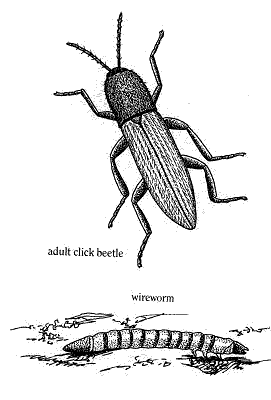Potato Traps
 |
Wireworms can be trapped with pieces of potatoes or whole carrots. Cut out the eyes and spear pieces of potato (no less than one half of potato) with sticks, and bury the pieces 2 to 4 inches in the soil, leaving a portion of the stick above ground. Set these traps 3 to 10 feet apart. The wireworms will feed on the potatoes. After a week, pull up your sticks, along with the potatoes and the wireworms inside. You can use these potato traps to determine in the first place whether the garden has wireworms. If you wish to take the time, and set dozens of traps, you can use this technique to reduce the number of wireworms to an acceptable level.
With carrots, plant full sized carrots still with their foliage in soil suspected of harboring wire worms. Plant these carrot traps about every foot or so. After about a week, pull the carrot, remove the worms, and replant the carrot to continue trapping.
This system does not work very well in a lawn unless you have some bare spots you can rough up in setting the potato pieces down into the soil.
Predatory Nematodes
Beneficial nematodes (available in stores and through mail order) applied to infested soil will help control wireworms. They burrow into the larvae, carrying with them bacteria that kill the larvae. This works well in lawns but is very expensive for anything but the smallest turf area. On the other hand, this approach is excellent for saving a section of a flower bed or a vegetable bed. See the file on Predatory Nematodes in Yardener’s Tool Shed.
Routine Cultivating in Gardens
If wireworms are a serious problem in your flower or vegetable garden, routine cultivating around plants (being careful not to disturb the roots) down as deeply as is feasible will bring up the wireworms and expose them to control by birds. Often you can see them as you hand cultivate and can pick them out of the soil and stomp on them.
Only In Extreme Situations - Tilling
Normally we don’t recommend tilling a vegetable garden every year. However, if you had serious wireworm problems during the season remove all garden debris in the fall and till or dig the soil down 8 inches, wait two weeks and then dig it down 2 to 4 inches. This disturbs the wireworm’s life cycle, disrupting its reproduction and thereby reducing its population. It also exposes the wireworms to birds and the weather.
Spiking Lawns
Wireworms often work near the surface of the soil in the late spring and throughout the summer. That is the time when you can kill many of them with some form of spiking tool with spikes that are quite sharp and at least two inches long. Golf shoes do not do the job, but special shoes with spikes attached to the bottom are now available. The more spike holes in the turf the more wireworms killed. Research shows that turf that is spiked frequently grows stronger root systems and therefore has better resistance to drought as well as insects.
Control Wireworms With Insecticides
There are no insecticides available to the homeowner to control wireworms in the home landscape. The chemicals available to farmers you would never want to be used in your yard.

